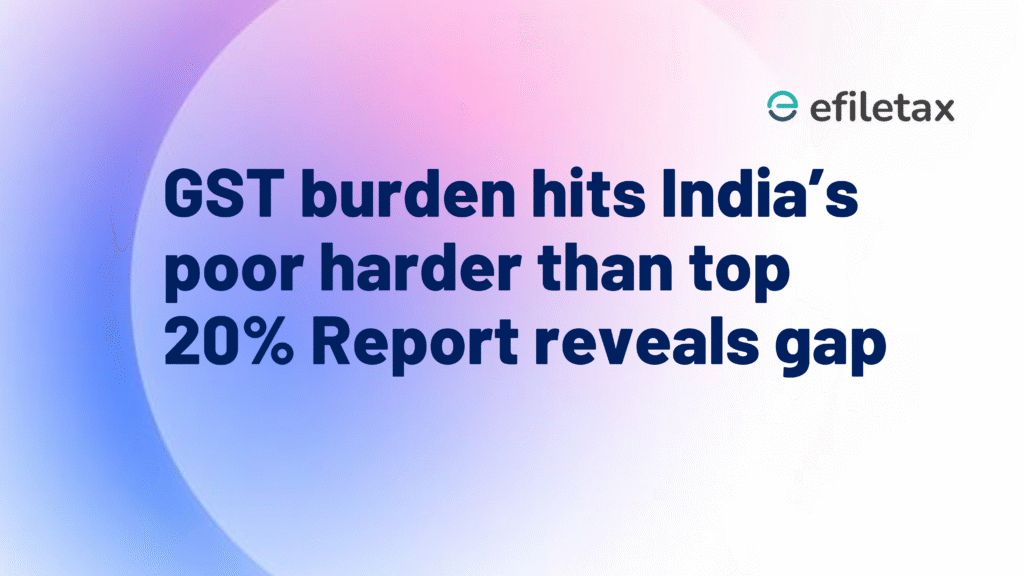
GST burden on bottom 50%: What the study reveals
A recent CEPR study on India’s GST system has uncovered a striking imbalance: the bottom 50% of consumers bear the same GST burden as the middle 30%, despite earning far less. Meanwhile, the top 20% pay proportionally less as a share of their consumption.
GST: A quick recap
Before diving deeper, here’s how GST works in India:
- GST (Goods and Services Tax) is a consumption-based indirect tax
- It’s levied at the point of purchase, irrespective of the buyer’s income
- Standard rates: 0%, 5%, 12%, 18%, and 28%
- Essential goods are taxed lower (0–5%), luxury items higher (28% with cess)
While designed as a unified tax system, GST lacks progressivity — meaning everyone pays the same rate, whether poor or rich.
Who pays what: Income group-wise GST burden
Here’s what the CEPR (Centre for Economic Policy Research) working paper, based on NSSO data, found:
| Consumer Group | Share of GST Paid | Share of Consumption |
|---|---|---|
| Bottom 50% | ~25% | ~20–25% |
| Middle 30% (50th–80th %) | ~35% | ~35–38% |
| Top 20% | ~40% | ~45%+ |
But when measured as a percentage of total income, the burden on the bottom 50% is much heavier.
🔍 Expert View:
As per Prof. Maitreesh Ghatak (LSE), “When indirect taxes dominate the tax system, the poor end up paying disproportionately. A progressive income tax offsets this, but India relies more on indirect levies.”
Why is this a concern?
- Regressive effect: GST doesn’t differentiate between a billionaire buying toothpaste and a labourer doing the same.
- Limited exemptions: Essentials like foodgrains may be tax-free, but daily items like soap, footwear, and mobile data still attract GST.
- Inverted inequality: High-income groups can afford taxed services (e.g., AC dining, branded clothes), but poor families feel the pinch on basic goods.
Budget 2025: Any relief in sight?
While Budget 2025 didn’t change GST slabs, it proposed:
- Better targeting of subsidies to low-income groups
- Increased direct transfers (DBT) to counter regressive effects
- Push for inclusion of petroleum under GST, which can ease input costs
But so far, GST Council hasn’t acted on slab restructuring or zero-rating more essentials.
GST Council’s legal role
- The GST Council, as per Article 279A of the Constitution, recommends tax rates and exemptions.
- Notification No. 1/2017 – CT (Rate) and its periodic amendments set effective GST rates on goods/services.
- Section 11 of CGST Act, 2017 empowers the government (on Council’s recommendation) to exempt goods/services.
Yet, as per CAG Reports, periodic rate revisions often favour industry lobbying, not low-income protection.
What can improve GST fairness?
Here are some practical steps policymakers could consider:
- Two-rate GST system (e.g., 6% for essentials, 12% for others)
- Zero-rating for key consumables below MRP ₹100
- Monthly GST cashback for Jan Dhan account holders
- Link consumption data with Aadhaar/DBT to auto-credit subsidies
Conclusion
Without serious reforms to make GST more progressive, the gap between consumption tax paid and actual income will only widen.
Want help managing GST compliance and saving legally?
Reach out to Efiletax — your partner in smart tax planning.
Summary
A new study shows India’s bottom 50% bear the same GST burden as the middle class, despite earning far less. With uniform tax rates on essentials, GST acts regressively, hitting poor households harder. Experts call for reforms to make India’s indirect tax system more equitable.
FAQs
Q1. Why is GST considered regressive?
Because it levies the same rate on all buyers, regardless of income hurting the more.
Q2. Does India have income-linked GST relief?
No. GST rates are uniform; relief (if any) is via DBT or subsidies, not rate variation.
Q3. Are any essentials exempt from GST?
Yes. Unbranded foodgrains, fresh vegetables, and some education/health services are zero-rated or exempt.
Q4. Has the GST Council proposed rate cuts for poor households?
Not specifically. Discussions on slab rationalisation have been ongoing, but no major relief yet.